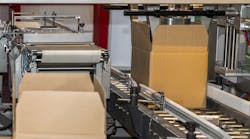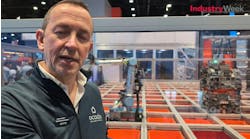Sean Webb is the director of sales and operations for North America with Sparck Technologies, a provider of automated packaging solutions. Prior to joining Sparck in 2018, he held equity trading positions at a number of firms, including E*TRADE and PEAK6. MH&L chief editor Dave Blanchard Plant Services recently spoke with Sean about the impact of ecommerce on companies, and why automating the packaging process can pay off in several ways for companies seeking competitive advantage.
Listen to Sean Webb on The Tool Belt Podcast
MH&L: Sean, if you could just give our listeners a brief overview of what exactly Sparck Technologies does and your role there, then we can get started with some questions.
Sean Webb: Sparck Technologies is a leader in automated packaging and what we do is create a right-sized box dynamically. As items are placed onto our system, we automatically scan those in and right-size them.
In this day and age of high productivity needed in warehouses and fulfillment, our system allows for a very flexible box that can be created on demand. It can create that right-sized box, and it can create all kinds of efficiencies in the operations process and create a lot of sustainability initiatives that companies are looking for.
MH&L: Thanks.
So what we do with our guests here on Supply Chain Insider, is we take a look at the supply chain from their perspective and certainly, Sean, your perspective is going to be different from some of the other people that we’ve talked to in previous podcasts. And that’s great because we want to create through the process of the podcast a bigger picture of what is going on out there in the world of supply chain.
So Sean, from your perspective—not necessarily the entire world’s, but from Sparck’s and your perspective—what do you see as being some of the biggest challenges that companies are seeing in their supply chains?
SW: What we’ve seen in the last few years is a large transition to an e-commerce type of environment where customers are getting very comfortable pointing and clicking and ordering online. This has created a necessity for the whole supply chain process to change how they’ve done it historically.
It’s created a lot of demands that fluctuate quite a bit and, as we’ve seen, it creates that need for automation in the other dynamic that plays into—that being the changes in the labor market that have occurred, starting with an e-commerce type of environment along with the pandemic and some of the different challenges that were created there. And it’s created a whole different environment for finding the labor needed to meet the demands of the customers and the fulfillment process.
So some of the challenges we’re seeing out there is moving from something that was a very manual process to an automated one that’s more efficient and able to keep up with those demands of this new environment.
MH&L: That leads to a natural follow-up question, which is how are companies dealing with those labor issues? Is it as simple as just saying, “I can’t find enough good workers, so I’ll buy some equipment”? How do companies deal with situations where they can’t get enough good people to stay with them?
SW: This is what we’re seeing right now. Obviously [companies] are looking for that labor and in all different parts of the warehouse.
But specifically in the packaging area, it’s one of those areas that has seen little automation over the years.
People have focused on automating the picking and other processes upstream and that labor demand is happening in the packaging area and they go to a lot of different, let’s call it tactics, to try to attract employees.
And that’s also having an effect by raising the cost of that labor.
So as [companies] do that and try to stick with the same model that they’ve used over the years, it’s amplifying the problem, if you will. So they’re turning now to automation and they’re really looking to be creative in finding whatever solution they can.
And in the end, as they look at it and understand what their application looks like, there are different automation solutions that will probably best fit their needs as they move forward.
In trying to address not only the cost of the labor as it’s going up, but also the flexibility as things go up and down, they’re able to have that flexibility with the automation.
MH&L: So [let’s talk about] that word: “automation.” When you hear from people who have particular supply chain issues, whether it’s with labor, whether e-commerce is just overwhelming them, whatever the case might be when they come to you and they say, “Hey Sean, we need to get automated,” do they even know what they want or do they just know that they need to get automated?
SW: I think that generally they’re not really sure what they’re looking for. A lot of times I think companies understand that they have problems in labor, transportation costs, material costs and so as they go through this process, I don’t think they really understand it other than they’re feeling the pain by not being able to meet their company’s goals or getting those orders out and they’re working longer hours. The finance people are seeing it in the cost of their business and they’re looking for different ways to compete.
So I think that we see it with those customers coming and talking to us from a variety of different angles. Some might know a specific challenge they’re looking to resolve, but others are really looking to start a conversation and learn about what solutions are out there and how we can put together the right solution for their application.
MH&L: OK, so let’s drill down a little bit and talk about your own area of expertise, automated packaging. Let’s assume that when someone comes and talks to you or your company, they kind of know that what they want is automation in their packaging processes.
So first of all, how does that help a company? What are some of the benefits for a company that’s overwhelmed by the demands of e-commerce? How can automating their packaging process help them?
SW: Great question. There are a couple of main areas [where] customers have a challenge and how an automated solution can help them.
Number one is in productivity. When you automate your process, you are able have a much higher level of productivity than you can with the individuals and doing it in a manual process. So that’s one big gain from automating: finding the labor to meet the needs of those customers in this day and age.
[It used to be] you could order something and that package would come in seven days, but as the market has kind of matured a little bit, the expectations are that customers receive those in, say, two days and the compression of that continues to evolve as well.
So automation really allows them to meet the needs of those customers.
That’s one big part of it. And then you see those savings they’re able to create that additional productivity with the automation creating that investment.
And then there are significant savings because of the cost of labor and you’re able to get that higher productivity. So what we see is about an 88% savings in the labor category.
When we look at someone’s ROI, in addition to that, as we go through this conversation and talk about automated solutions, once we right-size that box, the transportation savings come down dramatically as well. So then they’re able to realize additional savings to help pay for that investment. Another big area is the material cost. So once they right-size a box, they don’t need to add additional material into it to fill those void spaces or that extra air – any kind of air pillows or anything that they might put in there to package it right.
In addition, what we see is there are a lot of sustainability initiatives. Think of that smaller box—you can fit more onto a truck, and more boxes on a truck creates fewer truckloads. That creates a carbon footprint savings in addition to the, you know, cutting down fewer trees, not putting some of those plastics into the box that ends up in landfills. So more additional sustainability initiatives.
MH&L: We had talked before the podcast about the idea of bringing automation downstream. How does that process impact on the packaging process, bringing automation downstream? Talk about that a little bit, if you would.
SW: When you think about it, as someone is implementing automation upstream, whether it’s in their autostore or in the picking using robots or some other process, the next bottleneck that occurs is in the packing area.
You’re only as good as your weakest link in this process.
And so if you have challenges upstream and you’ve resolved those, you’re following the path all the way through the process and in the packing area what we’ve seen is that since there’s been such a big focus on automating upstream, it creates that natural kind of a larger demand to resolve those bottlenecks, which again amplifies the need for more manual labor to help in that packaging process.
Whereas when you can automate that and now that automation fits in and integrates with the rest of the facility, you’re able to have a very seamless flow and keep up with the productivity demands of the customer.
MH&L: I go to a lot of trade shows and conferences, supply chain and e-commerce and logistics related, and I often hear this question asked of exhibitors from potential customers, and so I’m going to ask you that same question: “How does a company know when it’s time to automate their packaging?” What would be a telltale sign that a company’s best option would be automating their packaging?
SW: Great question. I don’t think there’s any kind of specific silver bullet or one-size-fits-all answer to that, but certainly as companies are falling behind in meeting the needs of their customers, that’s one indication.
Another one is they simply can’t find the labor to meet the needs of their normal process, or if they have a peak season. Finding that labor and all the challenges that come with that.
I think as people go through those cycles, what we’ve seen is it’s a big indicator when you come out of a peak season and the whole team is just completely exhausted from the process and you’ve got to just start it all over again.
These are some of the signs that they need to take a look at automation in their business.
If they look ahead and see growth, how are they going to continue growing and meet those needs, right?
So if they have a 20% year-over-year growth and they’re struggling now to find labor as they look forward and plan out their business, that’s a big signal that they need to look at automation.
There’s a number of ways that it can start.
Those signals start showing it and kind of creating the need for a conversation around it and finding alternatives to solve those problems.
MH&L: Part 2 to that question would be, again if I’m a company who has issues with my packaging after you’ve explained to me and I’ve nodded my head and said, “Yeah, those are some of the problems we’re having right now. Those are some of the issues,” what will it take for a company to integrate all the various systems that they’ve got together if they want to get their packaging process automated?
Not to be too specific, since every company’s different, but what would that integration process kind of look like?
SW: The challenge in answering that directly is each company may be slightly different depending upon if they’ve started any automation in their process at all.
In the past, my answer might have been a little bit different, but I think it starts with first, having conversations and understanding what your options are. Beginning to automate is really not that difficult for a lot of companies to start. That’s why we’ve seen it in different sections of the supply chain process.
My advice is to start those conversations and don’t be afraid of automation.
In talking with a lot of different people, [some of them] have a fear and that fear kind of creates analysis paralysis. But they really just need to get moving.
And what I’ve seen is once customers start and get comfortable making a small change and moving towards automation, they understand the value of it and they start moving even faster and looking for ways to bring other investments into that whole automation process to solve their problems.
So I don’t think there’s any specific one area that I would say, start in this section or this other section. It’s really about looking at what are their goals, where are their bottlenecks, and start having those conversations with companies like ours or other partners that they’re working with.
MH&L: So what would be the ROI of an automated packaging solution? If I’m in a supply chain role and I have to convince the CFO or somebody else high up in the finance world that this is the way our company should be going and they ask, “What’s the ROI of automated packaging?”
What kind of answer do you and other sorts of packaging companies tell people that they can expect?
SW: I’ve got a background in finance and the return on this investment is really amazing.
It all does depend again on the application: the number of packages, what their growth opportunity looks like, how they’ve managed the business in the past. We see an investment that they can get a return on in 12 to 18 months and some customers even less than that.
So when you look at that, the ability to make that investment and get a return on it, it becomes a new revenue stream very quickly, which allows them to finance that growth It really is amazing and when finance people really dig into this and understand their business and how [they can achieve] an 88% savings on labor, a 32% savings in transportation and 38% savings in material cost, how those play into it, from a finance standpoint, it really allows people to move forward very quickly and understand the value of this type of automation.
MH&L: So wrapping up a little bit here, Sean, looking forward to the rest of the year, what do you expect to see happen with companies in automated packaging, since e-commerce doesn’t seem to be slowing down one bit right now?
SW: I think it’s just going to continue to grow. And I think what we’re going to see is newer, disruptive type technology. As companies get comfortable with it, they become more aware of it.
We’re going to see from a competitive standpoint, people are going to need to have this type of automation in order to remain competitive.
So we see this growing. As you think about the connection between the customer and the brand, we’re seeing a real focus now because people aren’t maybe coming into [retail] stores like they were. That is the relationship that these brands are creating with the customer and the packaging is becoming more and more important. So as we look forward, and I don’t think e-commerce is going away, we may start to see instead of the kind of growth that’s just been skyrocketing, maybe we’ll see that come down a little bit.
But I think that just allows companies the opportunity to have a window to automate and move forward and be competitive.
So I think it’s an exciting time for us in the right-size packaging automation sector and we’re really excited about the value it brings to these end customers.
MH&L: Fantastic.
We’ve been talking with Sean Webb with Sparck Technologies about the future of automated packaging and if it’s the right move for your company. Sean, thank you so much for your insights.
SW: Thanks, Dave. I appreciate your time today.




